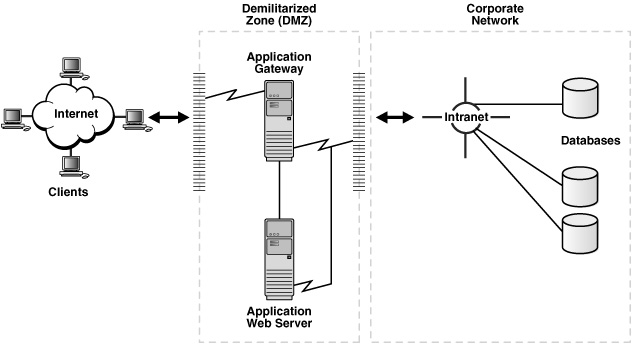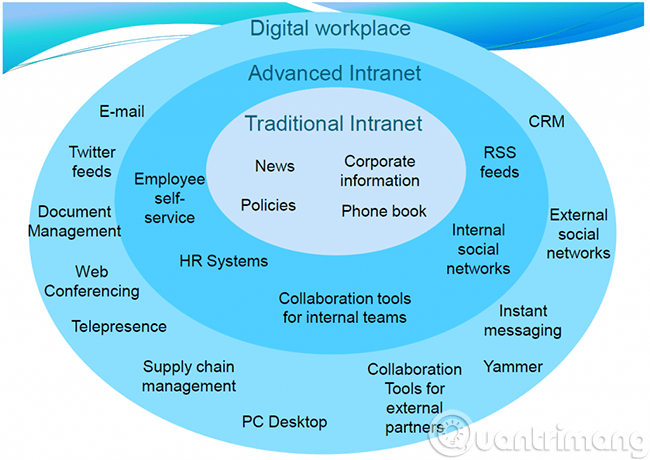Theory - What is Intranet?
Sure you have heard of intranet, so do you know what an intranet is? Is it different from the Internet? Today, let's go with TipsMake.com to discuss this concept.
- Network basics: Part 1 - Network hardware devices
What is an intranet?
Intranet is an internal (of course) network based on TCP / IP protocol, and this type of network is often applied in companies, businesses, schools . All members in All intranet systems that want to operate and access must have authentication information, including Username and Password. And sites based on intranet operate similarly to other Internet sites, but are protected by a Firewall layer, to protect the system from unknown sources.
For the same purpose as the Internet, intranet is used to exchange and share internal information. However, the intranet has an advantage that is protected by a firewall, meaning that the user must have a new account to access the system (different from the Internet in that the network is available, the computer is available).

Simple Intranet model
A more dissected way:
An intranet is a private network that is only accessible by authorized users. The "intra" prefix means "internal" and therefore implies that the intranet is designed for internal communication. "Inter" (as in Internet) means "middle" or "in the middle". Since there is only one Internet, the word "Internet" is capitalized. Because many intranets exist around the world, the word "intranet" is written often.
Intranets can be limited to a specific LAN, or can be accessed remotely via the Internet via a tunnel (tunel). Internal intranets are generally the most secure because they can only be accessed from within the network. To access an intranet over a wide area network (WAN), you often need to enter your login information.
Intranets serve many different purposes, but the main goal is to make communication within organizations and businesses easier. For example, an enterprise can create an intranet that allows employees to share messages and files securely. It also helps system administrators send messages and update all machines connected to the intranet more quickly and simply.
Most intranet network solutions have web interfaces for users to access. This interface provides information and tools for employees and group members. It can include calendar, project time, task list, secret files and a messaging tool to communicate with other users. The intranet website is often called a portal and can be accessed with an intranet URL. If the intranet is restricted to an intranet, the user will not be able to access it from (or out) outside the intranet.
Examples of intranet intranet services include Microsoft SharePoint, Huddle, Igloo, and Jostle. While some services are open source and free, most intranet solutions require a monthly fee. The cost is usually related to the number of users on the intranet, the more users the greater the amount of money to spend and vice versa.
Model, diagram of Intranet:

Good luck!
You should read it
- Deploy IPSec / VPN system on Windows Server 2003
- Honda's database leaked, revealing many 'deadly' weaknesses in the intranet system
- WEBSERVICE function - The function returns data from a web service on the Internet or Intranet in Excel
- Set up VPN within 15 minutes
- Block web browser with IPSec
- Set up the LAN by dividing the subnet
- Instructions for copying files on iTunes
- How to view the IP address, check the computer's IP
- What is Google Sites, and when should you use it?
- Fix the problem of 'dead' Internet connection
- The Windows 10 update made users 'lose their lives', now has an alternative
- How to block software from connecting to the Internet by Firewall
May be interested

Problem of taking photos in Decree 49/2017 / ND-CP

Experience in buying new laptops for students

How to block Windows 10 from tracking and collecting user information

10 tips for using Command Line Windows 10 users should know

Activate GodMode mode on Windows 10, 8 and 7

Instructions for fixing 'This app can't open' error on Windows 10





 What is an intranet? Is it a social network?
What is an intranet? Is it a social network? What is Hemingway? Tips for productivity using iceberg theory
What is Hemingway? Tips for productivity using iceberg theory TOP app supports the best driving test on phones
TOP app supports the best driving test on phones Deploy IPSec / VPN system on Windows Server 2003
Deploy IPSec / VPN system on Windows Server 2003 How to Learn Music Theory Online
How to Learn Music Theory Online How to Create Bifurcation Theory Catastrophe Curves in XL
How to Create Bifurcation Theory Catastrophe Curves in XL